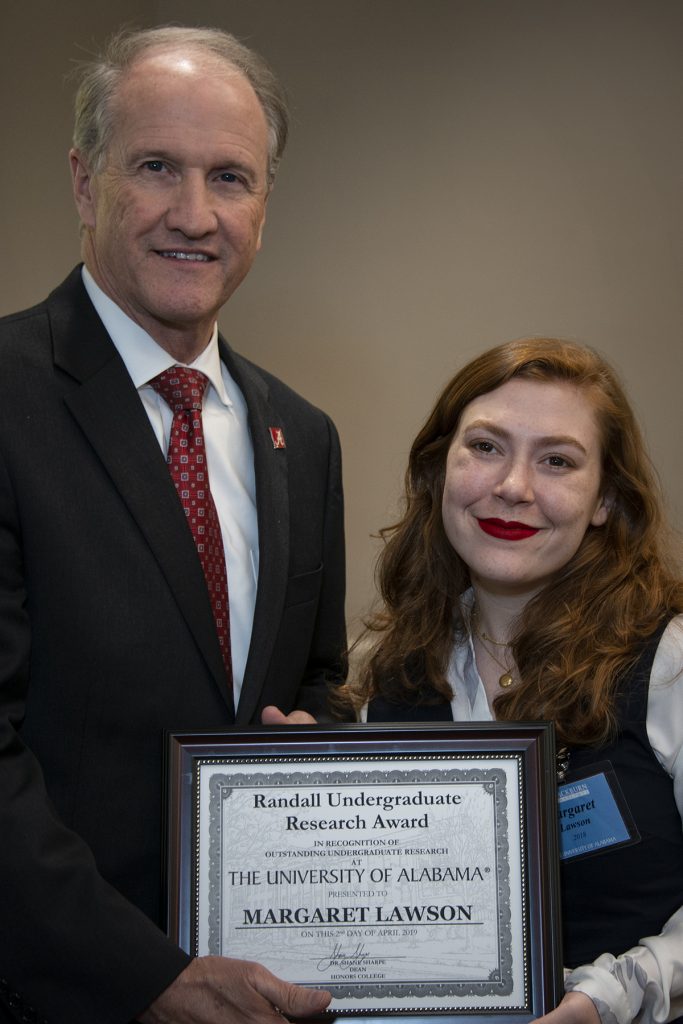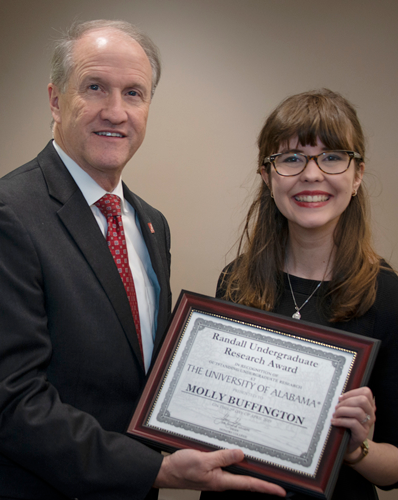
Two of our History majors – Molly Buffington and Margaret Lawson – recently received the prestigious Randall Outstanding Undergraduate Research Award, which recognizes undergraduate students who are involved in innovative research around campus. Margaret was recognized for her project “History of Us: Empowering High School Students to Confront the Legacy of Lynching.” Under the guidance of Dr. John Giggie, she worked to integrate new research on lynching in the American South into high school history curriculum.

Molly Buffington was also recognized for two projects, one her Honors Thesis with Professor Emeritus Dr. George McClure, “A Faith that Sings: Lutheran Liturgy as a Theological Tool in the Reformation,” and an on-going project with Dr. Kirk Summers in the Department of Modern Languages and Classics, “Hyperphysicism and Mystery in the Sacramentarian Dispute of the 1570s.” Both of her projects deal with ways the early Lutheran church solidified its beliefs in the first few decades of its existence. With Dr. McClure, she investigated at the development of a uniquely Lutheran liturgy; with Dr. Summers, she explored a caustic debate over the Ascension and the Eucharist between the Lutherans and the Calvinists.
Congratulations, Molly and Margaret! Read the abstracts from their projects below:
Molly Buffington
Title: A Faith That Sings: Lutheran Liturgy as a Theological Tool in the Reformation
Abstract: Martin Luther’s alteration of the Roman Catholic Mass into the Lutheran Gottesdienst (or “God’s service”) has been critiqued as an afterthought or an act of theological compromise to appease the conservative German princes and peasants. However, Luther’s worship rite, especially the ceremonies surrounding the Sacrament of Communion, was crafted to teach and comfort the faithful while also battling heterodoxy. Luther and those in his circle crafted a distinctly ”Lutheran” way to celebrate Communion in response to the needs of their congregations, especially with the undereducated peasantry in mind, as a means of explaining complex theological concepts through word and act. Further, they allowed for practices considered unnecessary in order to console the weak in faith or to facilitate the conversion of former Catholics. The early Lutheran Service of the Sacrament was even influenced by the arguments and liturgies of non-Lutherans, such as Zwingli, Karlstadt, Schwenkfeld, and others, as the Lutherans countered other teachings on Communion and even tried purposefully to offend non-Lutherans through their liturgical choices. Thus the liturgy was not intended as a static, repetitive rite as a means to itself, but rather an educational, pastoral, and polemic tool to deliver forgiveness of sins and strengthen the laity in their faith.
Title: Hyperphysicism and Mystery in the Sacramentarian Dispute of the 1570s
Abstract: During the late sixteenth century, a firestorm of religious debate swept across Germany, as the second generation of Protestant reformers launched into a new topic of controversy: the mystic relationship between the Eucharist and the substance of the body of Christ. At the heart of this research lies a tangled web of letters, catechisms, and confessional documents between “confessional” Lutherans (those who saw themselves as continuing in the legacy of Luther), “Crypto-Calvinist” Lutherans (those who borrowed from John Calvin and other Reformed theologians), and Reformed theologians, which primarily discuss the translation of the biblical passage Acts 3:21. This single verse, describing Christ’s ascension into heaven, engendered lively debate over the nature of Christ’s presence in the Supper and in heaven. The Reformed, notably Calvin’s successor Theodore Beza, and their Crypto-Calvinists allies taught that Christ’s body, as a rational, physical, and circumscribable body, was corporally located only in heaven and thus inaccessible through the Supper. However, the Lutherans, including Martin Chemnitz and Nicholas Selnecker, taught that Christ reigned in heaven in a glorified and hyperphysical state, thus his corporeal body could take on celestial attributes and be wherever he willed it to be. The topic reached such an importance that it was eventually included in the Lutheran Formula of Concord, a major confessional document published in 1580. This debate embodies some of the most divisive issues of the late Reformation and beyond, such as the roles of language, logic, the supernatural, paradox,and faith in matters of religious belief.
Margaret Lawson
Title: History of Us: Empowering High School Students to Confront the Legacy of Lynching
Abstract:
Involving the University of Alabama (UA), Central High School in Tuscaloosa, Alabama, and the Equal Justice Initiative (EJI) in Montgomery, Alabama, this project aims to create collaborative models for high school students to learn about and engage with local histories of racial injustice. “History of Us” will integrate new designs in experiential learning and community engagement in secondary social studies education with fresh research in the scholarship on lynching in the American South.
The key component of the project will be students from Central performing original research about local lynching victims. By conducting research through accessible online newspaper and genealogical databases, students will study the circumstances of victims’ deaths as well as the texture of their lives—their families, place of work, where they lived. Students will then explore how the culture of white supremacy that lay at the heart of lynching had far-reaching social implications in the Tuscaloosa community, including modern patterns of segregation, judicial inequality, and mass incarceration.
Ultimately the students will embed their work in a final project where they become historians and community activists in their own right. During the year, they will work with the Tuscaloosa Civil Rights Task Force, the Southern Christian Leadership Conference (SCLC), and EJI to bring a monument for local victims to Tuscaloosa. In May 2020, they will present their findings and reflections at a community conference whose highlight will be unveiling the monument. By claiming Tuscaloosa’s monument, Central students will become national leaders in a conversation about race, justice, and community.